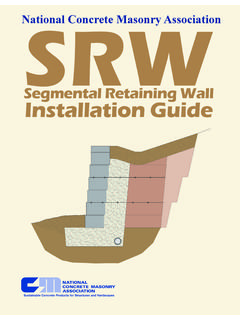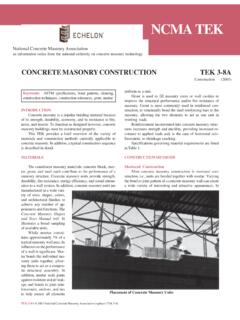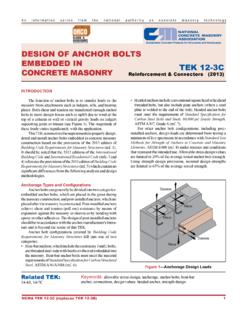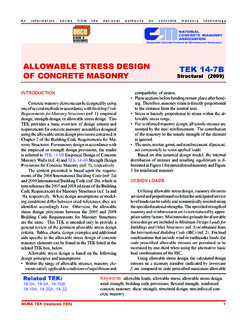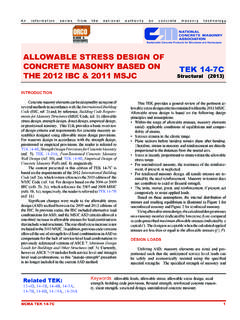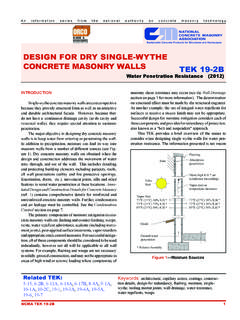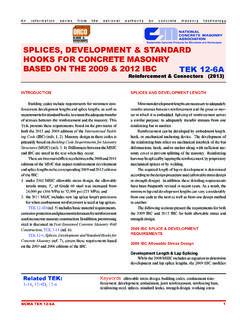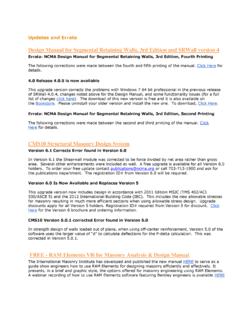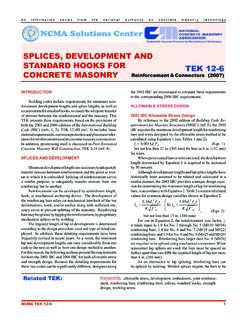Transcription of Installation Guide and Detailing Options for Compliance ...
1 For Adhered Manufactured Stone Veneer4th Edition 1st PrintingInstallation Guideand Detailing Optionsfor Compliancewith ASTM C17802 Masonry veneer Manufacturers 30, 2014 Installation Guide for Adhered Manufactured Stone veneer , 4th Edition 1st PrintingTable of Contents Definitions/Abbreviations ..4 References ..4 Summary Tables .. Requirements ..7 Surface Preparation ..8 Installation of Adhered Manufactured Stone veneer ..10 Cautions ..12 Drawings / Cross SectionsFigure 1. Installation Over Wood Framing ..13 Figure 2. Installation Over Concrete Masonry Units ..14 Figure 3. Wall Assembly ..15 Figure 4. Typical Wall Section ..16 Figure 5. Foundation Wall Base ..17 Figure 6 . Foundation Wall Base-AMSV Overlapping Foundation ..18 Figure 7. Foundation Wall-Transition to AMSV Continuing Down Foundation ..19 Figure 8. Cladding Transition ..20 Figure 9. Outside Corner ..21 Figure 10.
2 Inside Corner ..22 Figure 11. Horizontal Transition ..23 Figure 12. Vertical Transition ..24 Figure 13. Open Eave-Overhang ..25 Figure 14. Open Eave-Flush ..26 Figure 15. Rake-Overhang ..27 Figure 16. Rake-Flush ..28 Figure 17. Side Wall-Composition Shingles ..29 Figure 18. Side Wall-Composition Shingles Curbing ..30 Figure 19. Side Wall-Tile Roofing ..31 Figure 20. Side Wall-Tile Roofing Curbing ..32 Figure 21. Window Sill ..33 Figure 22. Window Jamb ..34 Figure 23. Window 24. Kick-Out Flashing ..36 Figure 25. Cricket ..37 Figure 26. Chimney Chase ..38 Figure 27. Column Base ..39 Figure 28. Raised Column Base ..40 Figure 29. Penetration, Flanged ..413 Masonry veneer Manufacturers 30, 2014 Installation Guide for Adhered Manufactured Stone veneer , 4th Edition 1st PrintingMasonry veneer Manufacturers AssociationNational Concrete Masonry Association13750 Sunrise Valley DriveHerndon, VA 20171 Phone: (703) Guide addresses generally accepted methods and details for the Installation of Adhered Manufactured Stone veneer .
3 To the best of our knowledge, it is correct and up to date. However, the document is designed only as a Guide ; and it is not intended for any specific construction project. The MVMA and NCMA makes no express or implied warranty or guarantee of the techniques, construction methods or materials identified is understood that there are alternative means or methods that might be required and/or recommended based on project conditions, manufacturer s recommendations, or product Guide for builders, architects, designers, masons, installers and other construction professionals illustrates typical applications of Adhered Manufactured Stone veneer . Details in this Guide that address the Installation and Detailing of Adhered Manufactured Stone veneer and its interface with other building components are not intended as specific recommendations.
4 It is the responsibility of all design and construction professionals to determine the applicability and appropriate application of any detail to any specific 2014 by the National Concrete Masonry Association. All rights reserved. 1st printingAboutMasonry veneer Manufacturers Association (MVMA), an affiliate of NCMA, represents the adhered manufactured stone veneer industry s manufacturing companies and their suppliers. The mission of the organization is to advance the growth of the manufactured masonry veneer products industry through proactive technical, advocacy, and awareness of Contents (continued)Drawings / Cross Sections (continued)Figure 30. Penetration Non-Flanged, with Building Paper WRB ..42 Figure 31. Penetration Non-Flanged, with Housewrap WRB.
5 43 Figure 32. Penetration, Fixture ..44 Figure 33. Penetration, Dryer Vent ..45 Figure 34. Deck Termination ..46 Figure 35. Wall Cap ..47 Figure 36. Wall Assembly-Optional Rainscreen System-Drainage System ..48 Figure 37. Wall Assembly-Optional Rainscreen System-Strapped ..49 Figure 38. Foundation Wall Base-Optional Rainscreen System ..50 Figure 39. Typical Wall Section-Optional Rainscreen System ..51 Figure 40. Retaining Wall (CMU) ..52 Figure 41. Wall-Section Interior Over Cement Backer Board ..53 Figure 42. Forward Mounted Commercial Window ..54 Figure 43. Forward Mounted Commercial Window-Top View ..55 Figure 44. Commercial Storefront Window-Top View ..56 Figure 45. Commercial Storefront Window ..57 Figure 46. Wall-Section Multi-Floor Joint Detail ..58 Figure 47. Wall-Section Over Rigid Insulation with Additional Sheathing ..59 Figure 48. Wall-Section Over Continuous Rigid Insulation CMU.
6 60 Figure 49. Wall-Section Inside Corner with Stucco-Top View ..61 Figure 50. Wall-Section Insulated Concrete Form (ICF)-Top View ..62 Figure 51. Wall-Section Over Continuous Rigid Insulation with Z Channels-Top View ..63 Figure 52. Wall-Section Over Continuous Rigid 64 Figure 53. Wall-Section Parapet with Stone Cap ..65 Figure 54. Wall-Section Parapet with Steel Cap ..66 Notes ..674 Masonry veneer Manufacturers 30, 2014 Installation Guide for Adhered Manufactured Stone veneer , 4th Edition 1st PrintingAdhered Manufactured Stone veneer (AMSV) lightweight, architectural, non load-bearing product that is manufactured by wet cast blending cementitious materials and aggregates, with or without pigments, admixtures, or other materials to simulate the appearance of natural stone and other masonry : The MVMA recognizes there are many names used to describe Adhered Manufactured Stone veneer products.
7 Adhered Manufactured Stone veneer is used commonly throughout the industry and by some manufacturers. In the International Building Code, Adhered Manufactured Stone veneer products are referred to as Adhered Masonry veneer . In the ICC-ES Acceptance Criteria, AC51, the product is called Precast Stone veneer . This Guide will use AMSV (Adhered Manufactured Stone veneer ) when referencing the The interior or exterior assembly to which AMSV systems are Concrete masonry A material applied to the surface of an AMSV assembly following construction for aesthetic purposes or to enhance one or more physical properties, such as resistance to staining or moisture (Degradation) Resistant A material that is intrinsically resistant to degradation or physically or chemically treated to be so under expected exposure conditions.
8 Examples include plastic-based materials stabilized for exposure to UV light, galvanized ferrous metals, and stainless Corrosion resistant hardware used to secure lath, screed, and flashing materials to backup Corrosion resistant material used to restrict the seepage of water around any intersection or projection of materials in an Corrosion resistant mesh building material fastened to the substrate to act as base for adhering A mixture of cementitious material, water, and aggregate, with or without the addition of admixtures or additives to alter one or more plastic or hardened properties, used to bond masonry construction materials together and fill spaces Mortar Mortar mixture used to fill joints and cavities in AMSV construction, also called grouting Scratch Coat Base coat of mortar used during the Installation of AMSV; cross-raked to improve bond of subsequent mortar Screen Sheet material installed to prevent the mortar scratch coat from filling the drainage space behind the AMSV Setting Bed Mortar used to adhere the AMSV to the substrate or scratch Resistive Barrier (WRB) Material used to restrict the transmission of water to the surface g BlockingLbs.
9 PoundsMfr s Manufacturer sMin. Pressure treated (wood preservative)Req d RequiredSAF Self Adhering FlashingReferencesAC38 ICC-ES Acceptance Criteria for Water Resistive BarriersAC51 ICC-ES Acceptance Criteria for Pre-Cast Stone VeneerAC275 ICC-ES Acceptance Criteria for Glass Fiber Lath used in Cementitious Exterior Wall Coating or Exterior Cement Plaster (Stucco)ANSI Accredited Evaluation Service An ANSI accredited (or equivalent) third-party organization that issues an evaluation report affirming a specific building product meets building code Code Council Evaluation Service (ICC-ES) An organization that performs technical evaluations on building products, components, and construction methods for building code Compliance . In the case where the building code is silent or ambiguous as to a product s requirements or a specific construction method, ICC-ES may develop Acceptance Criteria (AC) for the product or construction method.
10 Building Code (IBC) Building code that provides minimum requirements for safety, health, and welfare of life and property from hazards of the built environment. The provisions of this code apply to the construction, alteration, addition, replacement, repair, use and occupancy of all buildings except one and two family dwellings, and single-family townhomes not more than three stories in height. Residential Code (IRC) Building code that provides minimum requirements for safety, health, and welfare of life and property from hazards of the built environment. The provisions of this code apply to the construction, alteration, addition, replacement, repair, use and occupancy of detached one and two family dwellings and single-family townhomes not more than three stories in height. American National Standards Institute, American National Standards Institute Specifications for Dry-Set Portland Cement MortarANSI American National Standards Institute Specifications for Modifed Dry-Set Cement MortarsANSI American National Standards Institute Specifications for Improved Modified Dry-Set Cement MortarTMS 402 Building Code Requirements for Masonry Structures (TMS 402/ACI 530/ASCE 5).
